Athlete empowerment enables individuals in sports to advocate for their rights and well-being. This article explores effective advocacy techniques, essential resources like mentorship programs and educational workshops, and notable case studies demonstrating the impact of empowered athletes. Understanding cultural influences on advocacy strategies and recognizing common pitfalls will enhance the effectiveness of athlete empowerment efforts.
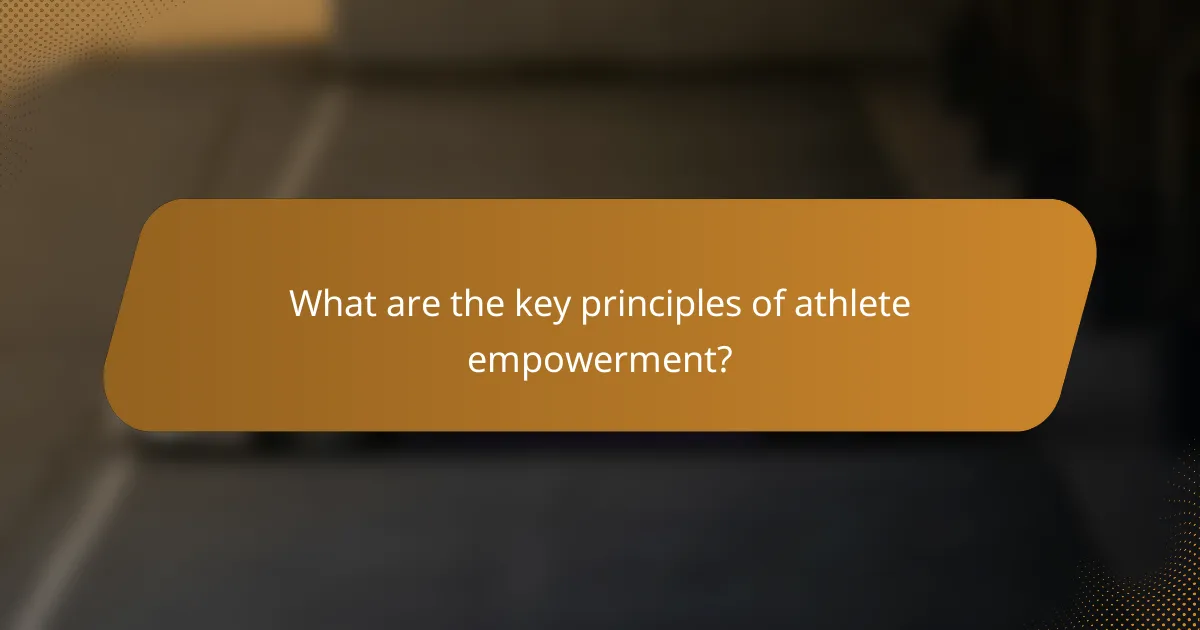
What are the key principles of athlete empowerment?
Athlete empowerment focuses on enabling athletes to advocate for their rights and well-being. Key principles include fostering self-advocacy, promoting informed decision-making, and encouraging collaboration with stakeholders. These principles help athletes navigate challenges and enhance their performance. Additionally, providing access to resources and support systems is crucial for sustained empowerment. Engaging in case studies demonstrates effective advocacy techniques and real-world applications, illustrating the impact of athlete empowerment in various sports contexts.
How does athlete empowerment enhance performance?
Athlete empowerment enhances performance by fostering confidence, autonomy, and resilience. Empowered athletes advocate for their needs, leading to better mental health and improved focus. Resources like mentorship programs and workshops further develop skills, while case studies show significant performance gains. For instance, athletes who engage in advocacy report higher motivation levels and greater commitment to training.
Why is advocacy important for athletes?
Advocacy is crucial for athletes as it empowers them to voice their rights and influence change. Through advocacy, athletes can address issues like mental health, fair treatment, and social justice. For instance, the rise of athlete-led movements has led to significant reforms in policies governing sports organizations. Empowering athletes through advocacy enhances their ability to navigate challenges and promotes a culture of support and accountability within the sports community.
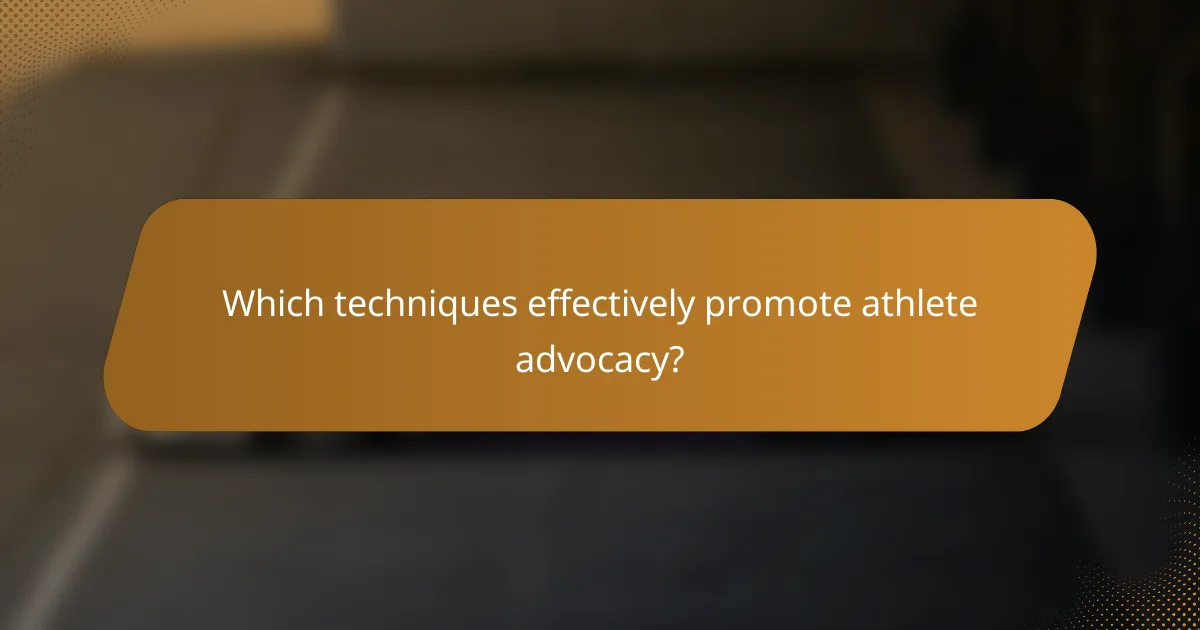
Which techniques effectively promote athlete advocacy?
Effective techniques for promoting athlete advocacy include education, collaboration, and leveraging social media. Education empowers athletes with knowledge about their rights and responsibilities. Collaboration fosters partnerships with organizations, enhancing advocacy efforts. Social media serves as a powerful platform for athletes to share their experiences and mobilize support. Each technique amplifies athlete voices, driving positive change in sports culture.
How can social media be leveraged for athlete empowerment?
Social media can empower athletes by amplifying their voices and facilitating advocacy. Platforms enable athletes to share personal stories, raise awareness on social issues, and mobilize support. For instance, campaigns like “Black Lives Matter” have seen athletes use their influence to drive social change. Additionally, social media provides resources for athletes to connect with advocacy organizations, enhancing their impact. Engaging with followers fosters community and encourages collective action, making social media a powerful tool for athlete empowerment.
What role do mentorship programs play in athlete advocacy?
Mentorship programs play a crucial role in athlete advocacy by providing guidance, resources, and support. They empower athletes to navigate challenges, enhance their skills, and amplify their voices in various contexts. Through mentorship, athletes gain access to experienced professionals who can share insights on advocacy techniques, helping them to effectively address issues in sports and society. Additionally, successful case studies demonstrate the positive impact mentorship has on athlete confidence and community engagement, fostering a culture of advocacy within sports.
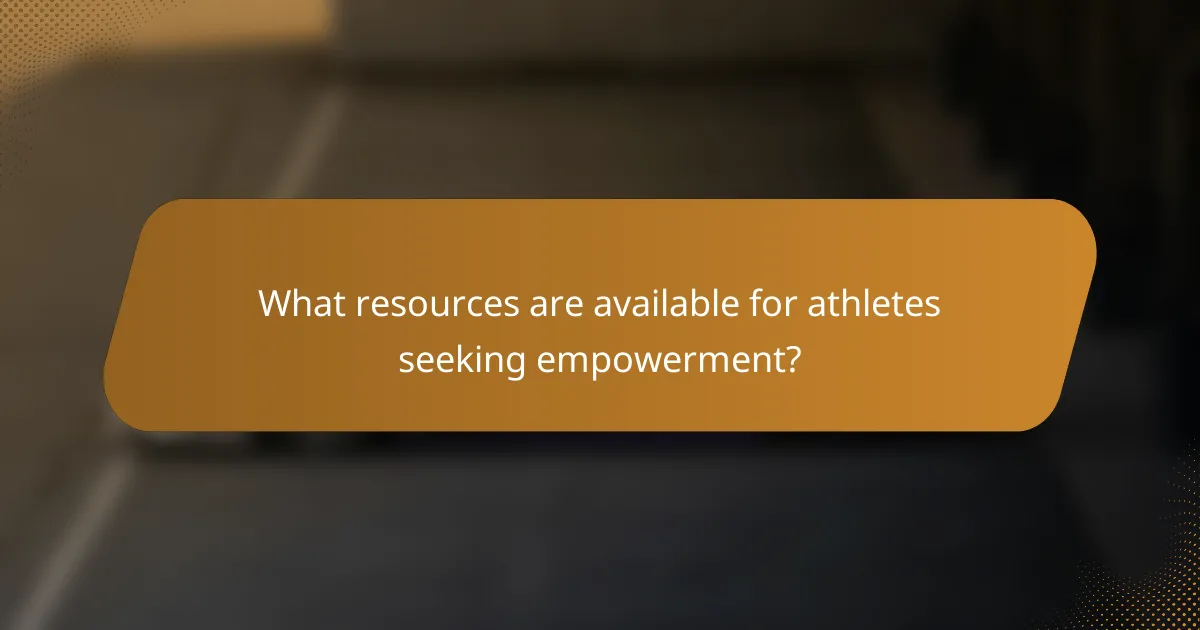
What resources are available for athletes seeking empowerment?
Athletes seeking empowerment can access various resources, including advocacy organizations, mentorship programs, and educational workshops. These resources provide support and guidance to help athletes navigate challenges and enhance their personal and professional growth.
1. Advocacy Organizations: Groups like the Athlete Ally and the Women’s Sports Foundation offer resources and support for athletes facing discrimination and seeking to promote equity in sports.
2. Mentorship Programs: Initiatives connecting experienced athletes with younger ones foster empowerment through guidance and shared experiences.
3. Educational Workshops: Programs focusing on mental health, leadership, and career development equip athletes with essential skills for empowerment.
4. Case Studies: Success stories of empowered athletes serve as inspiration and practical examples of overcoming obstacles and advocating for change.
Which organizations support athlete advocacy initiatives?
Various organizations support athlete advocacy initiatives, including the Athlete Ally, the Professional Athletes Coalition, and the Women’s Sports Foundation. These entities focus on empowerment, equity, and social justice within sports. Their resources include educational programs, legal assistance, and networking opportunities to enhance athlete advocacy efforts.
How can athletes access legal resources for advocacy?
Athletes can access legal resources for advocacy through various organizations, online platforms, and professional networks. They can connect with legal aid organizations specializing in sports law, utilize athlete associations for guidance, and seek pro bono services from law firms. Additionally, online resources like webinars and forums provide valuable information and networking opportunities.
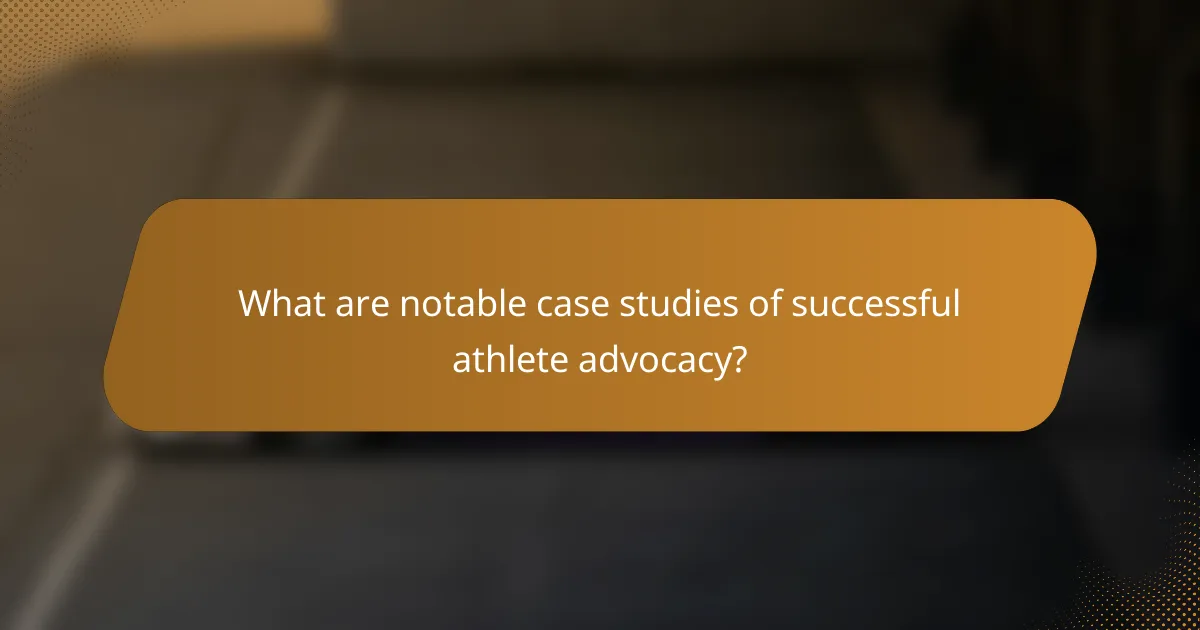
What are notable case studies of successful athlete advocacy?
Notable case studies of successful athlete advocacy include Colin Kaepernick’s protest against racial injustice, which sparked a nationwide conversation. Another example is Megan Rapinoe’s fight for equal pay in women’s soccer, leading to significant changes in compensation structures. LeBron James has also used his platform to advocate for social justice, influencing public policy and community initiatives. These cases highlight the impact athletes can have on social issues through advocacy techniques and resources.
How did specific athletes influence policy changes?
Specific athletes have significantly influenced policy changes through advocacy techniques and strategic partnerships. Their ability to leverage platforms and public attention has resulted in reforms across various sectors, including sports, social justice, and health.
Notably, athletes like Colin Kaepernick have used their visibility to address racial inequality, prompting discussions and policy shifts within organizations and communities. Similarly, LeBron James has championed educational reforms, leading to initiatives that support underprivileged youth.
These cases exemplify how athlete empowerment can drive meaningful change, highlighting the effectiveness of advocacy resources such as social media and community engagement. The unique attribute of their influence lies in their personal narratives, which resonate with the public and amplify their messages.
What lessons can be learned from recent athlete-led movements?
Recent athlete-led movements teach valuable lessons about advocacy and empowerment. These movements demonstrate the importance of using platforms for social change and raising awareness on critical issues.
Athletes have shown that collective action amplifies voices, leading to significant societal impact. For instance, the Black Lives Matter movement gained traction through athlete endorsements, highlighting racial injustice.
Moreover, these movements emphasize the need for resources and support systems for athletes engaging in advocacy. Access to training and guidance helps athletes navigate complex social issues effectively.
Lastly, case studies reveal that sustained commitment is essential. Successful movements often involve long-term strategies, fostering community engagement and collaboration with organizations.
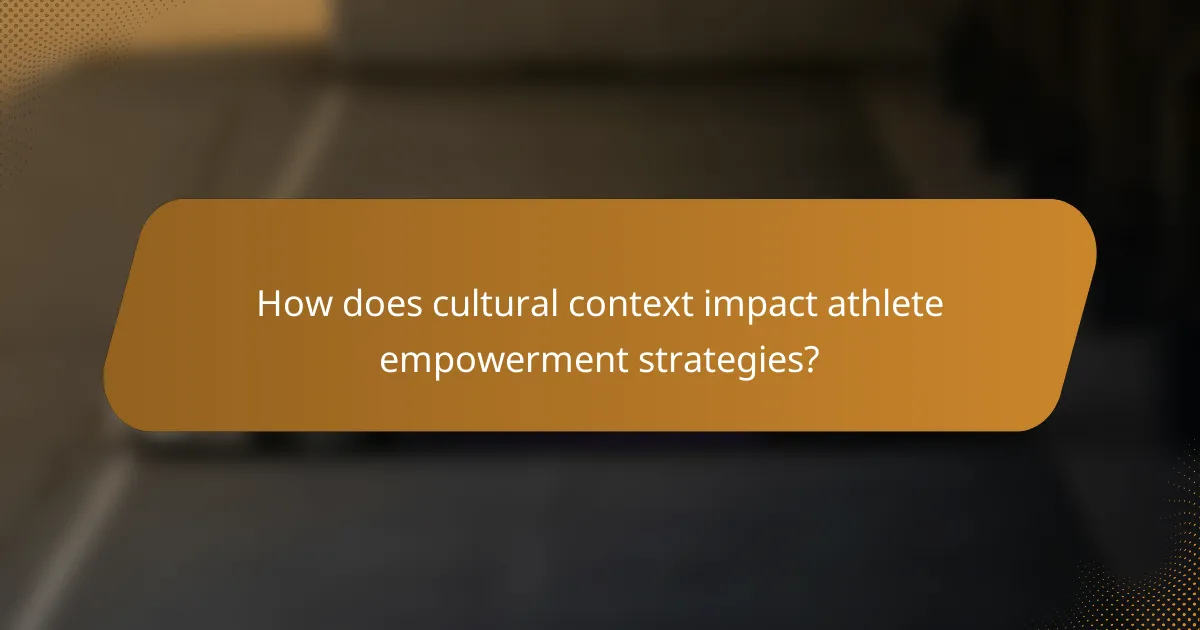
How does cultural context impact athlete empowerment strategies?
Cultural context significantly influences athlete empowerment strategies by shaping the values, beliefs, and practices within sports. Different cultures prioritize unique aspects of athlete advocacy, impacting how strategies are designed and implemented.
For instance, in collectivist societies, athlete empowerment may focus on community support and teamwork, while individualistic cultures might emphasize personal achievement and self-advocacy. This variation affects resource allocation, training programs, and the overall approach to athlete rights.
Additionally, cultural attitudes toward authority can dictate how athletes engage with governing bodies. In cultures with high respect for authority, athletes may be less likely to challenge decisions, while in more egalitarian societies, open dialogue and activism are encouraged.
Case studies illustrate these dynamics, showing that successful empowerment strategies are often tailored to align with cultural expectations. Understanding these nuances fosters more effective advocacy techniques that resonate with athletes’ lived experiences and cultural identities.
What unique challenges do athletes face in different regions?
Athletes face unique challenges based on their region’s resources, climate, and cultural attitudes. For instance, athletes in developing regions often lack access to training facilities and coaching. In contrast, those in urban areas might contend with high competition and pressure. Additionally, climate impacts performance; athletes in hot regions may deal with heat-related illnesses, while those in cold areas face injury risks from icy conditions. Cultural factors can also influence support systems, affecting motivation and mental health. Addressing these challenges requires tailored advocacy techniques and resource allocation.
How do local sports organizations adapt advocacy techniques?
Local sports organizations adapt advocacy techniques by focusing on community engagement, collaboration with stakeholders, and leveraging social media. They empower athletes through training programs and resources that enhance their advocacy skills. For example, organizations provide workshops on effective communication and public speaking, enabling athletes to articulate their needs and perspectives. Additionally, case studies illustrate successful advocacy campaigns, showcasing how local sports entities have influenced policy changes and increased funding for youth programs. These adaptations reflect a commitment to athlete empowerment and community development.
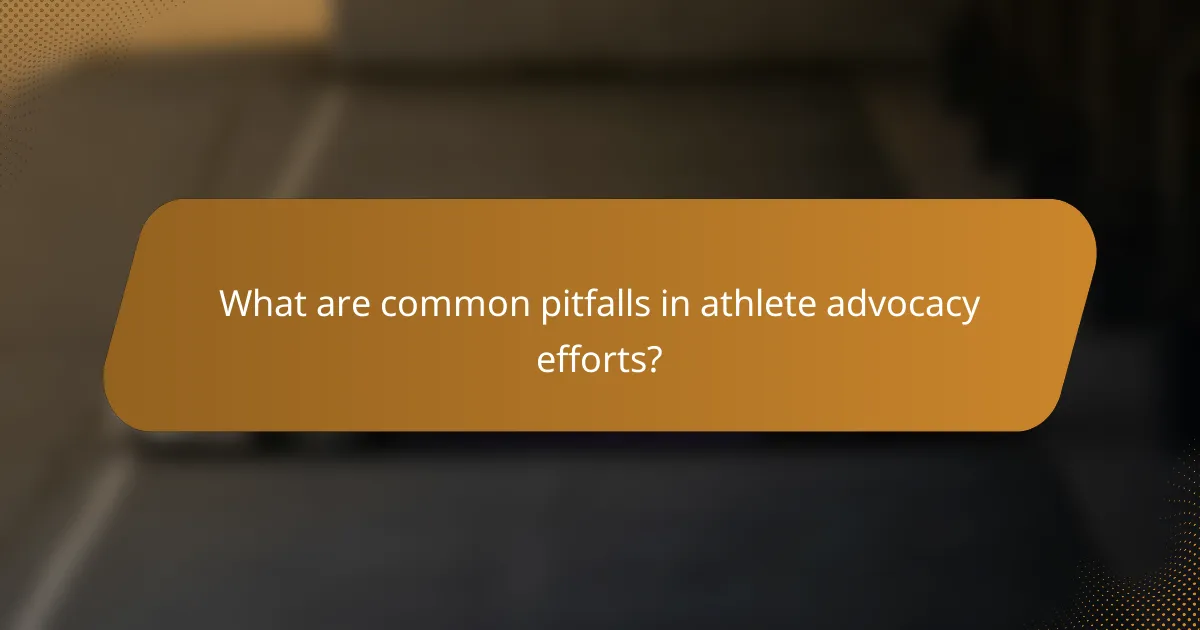
What are common pitfalls in athlete advocacy efforts?
Common pitfalls in athlete advocacy efforts include lack of clear messaging, insufficient stakeholder engagement, and failure to address diverse athlete needs. These issues can hinder the effectiveness of advocacy campaigns. For example, unclear messaging can confuse audiences and dilute the intended impact. Engaging stakeholders, such as coaches and sports organizations, is crucial for building support and ensuring a unified voice. Additionally, advocacy efforts must consider the unique backgrounds and experiences of athletes to resonate authentically.
How can athletes avoid burnout while advocating?
Athletes can avoid burnout while advocating by setting clear boundaries, prioritizing self-care, and seeking support. Balancing advocacy with personal needs is essential. Establishing a routine that includes rest and recovery helps maintain mental and physical health. Engaging in community support networks provides encouragement and shared experiences, reducing feelings of isolation.
What mistakes should athletes watch out for in their advocacy?
Athletes should avoid common mistakes in advocacy to ensure effective communication and impact. Failing to research issues thoroughly can lead to misinformation. Overlooking audience engagement may diminish the message’s reach. Neglecting emotional storytelling can weaken connections with supporters. Ignoring collaboration with other advocates limits collective strength. Lastly, being inconsistent in messaging can confuse followers and undermine credibility.
What best practices can enhance athlete empowerment initiatives?
To enhance athlete empowerment initiatives, organizations should prioritize athlete involvement, education, and resource accessibility. Engaging athletes in decision-making fosters ownership and motivation. Providing educational resources on rights and advocacy equips athletes with necessary skills. Case studies demonstrating successful initiatives serve as inspiration and guidance. Collaboration with stakeholders amplifies impact and leads to sustainable change.
